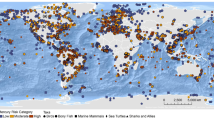Abstract
Data are presented for210Po levels in edible parts of marine species significant in the diet of the Argentine population. The sample collection sites were situated between 35° and 45° S in the Atlantic Ocean. The specific activities obtained, expressed per wet veight and with a 95% confidence level, ranged between 31.3±9.1 mBq kg−1 for pollack (Genypterus blacodes) and 1790±280 mBq kg−1 for squid (Illex argentinus). Hake (Merluccius hubbsi) followed by squid are the major contributors to the dose. The annual committed effective doses were 0.7 mSv and 0.6 mSv and the effective collective doses were 24 man·Sv and 20 man·Sv, respectively, for these species. For the remainder, because of both their low consumption rates and low specific activities, the corresponding doses were negligible compared with the former.
Similar content being viewed by others
References
R.D. Cherry, M. Heyraud,Science, 218 (1982) 5456.
B.T. Hargrave et al.,Deep Sea Research, 39 (1992) 37.
W.C. Camplin, A. Aarkrog, Radioactivity in North European Waters. pp. 199–320. In: The Radiological Exposure of the Population of the European Community from Radioactivity in North European Marine Waters, Project Marina, EUR 12483EN, CEC, Luxembourg, 1990.
R.A. Jeffries, J.B. Twining, Proceedings of a Workshop on Environmental Radiochemistry and Radionuclide Measurement, Adelaide, 1990.
Flota Pesquera Argentina, Capturas Totales 1992, Ministerio de Economia, Obras y Servicios Públicos, Secretaria de Agricultura, Ganaderia y Pesca, Subsecretaria de Pesca, Dirección Nacional de Pesca y Acuicultura.
K. Bunzl et al.,Health Phys., 37 (1979) 323.
R.B. Holtzman,J. Radioanal. Nucl. Chem., Articles, 155 (1987) 59.
J.D. Smith, T.F. Hamilton,Anal. Chim. Acta, 160 (1984) 69.
C.H. Colangelo et al.,J. Radioanal. Nucl. Chem., Lett., 166 (1992) 195.
B. Skwarzec, L. Falkowski,J. Environ. Radioactivity, 8 (1988) 99.
M. Heyraud, R.D. Cherry,Marine Biology, 52 (1979) 227.
ICRP Draft Recommendations, ICRP/90/G/01 (1990).
A.W. Phipps et al., NRPB-R245 (HMSO) (1991).
F.P. Carvalho,Radiat. Protect. Dosimetry, 24 (1998) 113.
D. Beninson,UNSCEAR 72, 1 (1972) 82.
Author information
Authors and Affiliations
Rights and permissions
About this article
Cite this article
Colangelo, C.H., Huguet, M.R. & Oliveira, A.A. Levels of210Po in marine species of the south Atlantic Ocean. Journal of Radioanalytical and Nuclear Chemistry Letters 188, 65–71 (1994). https://doi.org/10.1007/BF02164983
Received:
Accepted:
Issue Date:
DOI: https://doi.org/10.1007/BF02164983




